Experiencing internet drops can be highly disruptive, mainly if you rely on it for work or other activities.
We designed this guide to help you troubleshoot and resolve Starlink internet disconnection issues, ensuring you can work or enjoy online activities without interruptions.
Starlink offers internet coverage in almost every location, providing a sense of reassurance. However, some users still encounter issues with their Starlink connection, even in these widespread areas.
Some of these disconnections last for more than a few hours. What can cause this behavior, and are there any solutions to this problem?
This guide will point you to some possible reasons why Starlink keeps going offline and show you some quick fixes so you can work online without these disturbances.
Ultimately, we also provide alternatives you can use alongside Starlink so you can always stay online. The fixes are easy to perform, so you do not need in-depth knowledge. Let’s fix your connection.
What are the common causes of Starlink disconnections?

Obstruction
Though this can be overlooked, one leading cause of Starlink disconnecting is obstruction in the line of sight of your Starlink dish.
Obstructions cause signal dropouts. Starlink’s App provides a valuable feature to check for obstructions before installing your equipment.
Users often utilize this feature solely while installing their Starlink dish, overlooking that obstructions can arise at any time while using the service.
Some obstructions can occur after your installation, including telecom installations, trees growing over time, and trees swaying into the path during particularly windy conditions.
Checking the visibility status on http://dishy.starlink.com/ can help identify and address these obstructions. If obstructions are causing the issue, the best solution is to reposition the Starlink dish to ensure a clear, unobstructed view of the sky, minimizing signal loss.
Server Update
The constant interruptions can sometimes be due to an issue on Starlink’s side, such as a server update.
Server updates are a routine part of maintaining and enhancing service quality.
If interruptions continue for a long time, contacting Starlink support is advisable to determine whether these issues relate to ongoing server updates.
Interference
Interference is a common issue that can disrupt Starlink’s connectivity. Various sources, such as military equipment or nearby 5G antennas, can create interference that affects the performance of your Starlink dish.
In areas with high electromagnetic activity, such as military bases, the jamming capabilities of local equipment can significantly disrupt the signal. This interference often increases with the dish’s elevation, leading to more frequent disconnections when mounted higher. Keeping the dish at ground level in such areas can help mitigate these disruptions.
Also, residential areas with multiple 5G antennas can interfere with the Starlink signal. These antennas, mainly when located within 50 to 200 meters of the dish, can cause significant connectivity issues. In such cases, remounting the dish to a different location, away from the roof or other high points, can improve stability.
Improper installation
Improper installation can lead to frequent disconnections and reboots.
Ensuring you correctly balance the Starlink dish on the surface is crucial.
An unstable setup can cause intermittent connectivity issues, affecting the overall performance of your internet service.
Always double-check the stability and positioning of your equipment to maintain a consistent connection.
How to ensure the Starlink dish is balanced and stable on the surface
Choose a Flat Surface: Place the dish on a stable, level ground or surface.
Use the Provided Stand: Ensure the dish is securely attached to its stand.
Check for Obstructions: Ensure no nearby obstructions block the dish’s view of the sky.
Secure the Stand: Use sandbags, weights, or ground stakes to stabilize the stand, especially in windy conditions.
Level the Dish: Use a bubble level to ensure the dish is perfectly horizontal.
Starlink keeps going offline: 7 Easy Ways To Troubleshoot It

Before considering a factory reset for your Starlink router, there are several troubleshooting steps you can take.
Many of our dedicated users have successfully resolved disconnection issues by following these simple steps, demonstrating the power of user-initiated troubleshooting.
Inspecting The Dish Cable
Regularly inspect the cables connecting the Starlink dish to the Wi-Fi router.
Ensure they are securely connected and undamaged, as cable issues can lead to connection problems.
If you find any damage to the cable, consider replacing it. Replacing the damaged cable will quickly resolve the connectivity issues. You can find Starlink replacement cables here.
Using Genuine Ethernet Cables
When troubleshooting Starlink disconnection issues, using genuine, high-quality Ethernet cables is crucial.
Substandard or damaged cables can lead to frequent disconnections.
If you’re experiencing persistent problems, consider replacing your current cable with a genuine one to ensure a stable connection.
Reseat the dish cable.
One practical troubleshooting step for Starlink disconnection issues is to reseat the dish cable.
Over time, connections can loosen, causing intermittent connectivity problems.
Carefully disconnect the cable from the dish, inspect it for any damage or debris, and securely reconnect it.
Ensuring a tight, clean connection can often resolve disconnection issues and restore stable internet service.
Change Ethernet adapter
A faulty Ethernet adapter can often be the culprit behind Starlink disconnection issues.
If you experience persistent connectivity problems, try replacing your Ethernet cable or adapter.
Some Starlink users have found that using different or new adapters resolved these issues.
If you have an older round dish with a non-removable Ethernet cable, consider contacting Starlink support for an updated dish model with a removable cable.
Check the power outlet.
Ensure you plug your Starlink router into a dedicated power outlet.
Shared outlets can lead to insufficient power, causing connectivity issues.
Verify that all cables are securely connected and consider trying a different outlet to rule out power-related problems.
Resetting the dish
If you’re experiencing disconnection issues with your Starlink, a factory reset on the dish can help restore stable connectivity.
To do this, manually reset your dish and reconfigure it, including setting it back to bypass mode if necessary.
This method has been effective for our users, providing extended periods of uninterrupted service.
If disconnections persist, consider reaching out to Starlink support for further assistance.
Contact support for a new Router.
Persistent disconnection issues with Starlink service might stem from router problems.
It’s advisable to contact Starlink support to discuss the possibility of a router replacement.
Support can often provide a new router and Ethernet adapters, restoring a stable and reliable connection.
4 Tips for maintaining a stable Starlink internet connection
While there may be constant drop-offs in Starlink internet connections, there are some tips you can incorporate to maintain a stable Starlink connection.
This section outlines some practical tips to ensure your internet connection always performs at its best when needed.
Regularly clean your Starlink dish.
Think of your Starlink dish as a space telescope for your internet.
Just like any high-tech equipment, it benefits from regular cleaning.
Dust and debris can build up on the antenna surface, weakening the signal. A quick wipe-down with a soft, dry cloth will improve your connection.
Minimize interference
Signal strength can be affected by where you place your router. Here are two ways to get the most out of your setup:
Proximity is vital: Move your Starlink router closer to the devices that use the internet the most. Moving it reduces signal weakness and keeps things running smoothly.
Less is more: Too many devices fighting for bandwidth can slow things down. Disconnect unused devices to free up bandwidth for the tasks that matter.
Snow melting
For those battling the elements, Starlink has a built-in snow-melting feature.
Activate this feature during winter to prevent snow buildup on your dish. A clear dish translates to a clear signal!
Stay updated
Starlink is constantly evolving. Check the Starlink app for the latest software updates and ensure your system runs on the most optimized version.
Can Starlink be combined with another internet connection for better reliability?
Yes, Starlink can be combined with another internet connection to enhance reliability. Here’s how you can achieve this:
Choose a Secondary Connection: Get an additional internet service, such as cable, DSL, or a tethered mobile phone.
Use a Bonding App: Install a bonding application like Speedify on your devices. These apps combine multiple internet connections to provide improved speed and reliability.
Set Up the Bonding App: Download and install Speedify or a similar app on your device. Then, follow the App’s instructions to connect your Starlink and secondary internet service.
Optimize Your Setup: Ensure both internet sources are active and properly configured within the bonding app for optimal performance.
Adding a secondary connection and using a bonding app alongside Starlink can improve internet stability during network issues or satellite interruptions.
Final Thoughts
In conclusion, maintaining a stable Starlink connection is crucial for individuals relying on internet connectivity for remote work or other activities.
You can troubleshoot and resolve disconnection issues by addressing potential problems such as obstructions, server updates, interference, and improper installation.
By following the tips and guidelines outlined in this guide, you can work towards achieving a reliable and uninterrupted Starlink internet connection.

